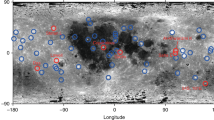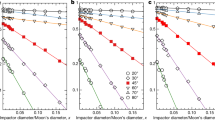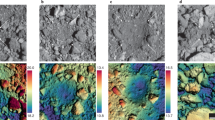Abstract
The bombardment of impactors (leftover planetesimals, asteroids and comets) created numerous impact craters on the Moon. The giant planets in the outer Solar System are believed to have experienced a dynamical instability, in which the migration of giant planets delivers impactors to the inner Solar System bodies1,2. The difference between the population of large (diameter more than ~5 km) impact craters observed on heavily cratered lunar highlands and that on the lunar maria3 was thought to support the lunar Late Heavy Bombardment, which started ~0.6 billion years after planet formation and could have been caused by the late instability of giant planets4,5,6. However, large craters on various-aged lunar surfaces have similar size–frequency distributions when considering the preferential erasure of small craters7,8. In addition, dynamical and geochemical evidence favour an early instability of giant planets at ~4.5 Gyr ago2,5,9. Here, we report the evolution at geological scales of regolith thickness on the Moon, which is a proxy for the change of the size–frequency distribution slope for Earth–Moon impactors with diameters less than ~50 m (which generate craters with diameters less than ~1 km (ref. 10)). We found an abnormally slow growth of regolith thickness per unit of impact flux before \(3.5_{ - 0.6}^{ + 0.3}\) Gyr ago (3σ uncertainty), which can best be explained by a population of craters of less than ~1 km whose size–frequency distribution had a shallower power-law slope (\(- 2.57_{ - 0.16}^{ + 0.30}\)) than that afterward (\(- 3.24_{ - 0.06}^{ + 0.03}\)). The transition time at ~3.5 Gyr ago supports the early instability of giant planets, in which dominant Earth–Moon impactors changed from leftover planetesimals to asteroids5. The value of −3.24 is consistent with the preferential delivery of small asteroids via Yarkovsky–YORP effects11.



Similar content being viewed by others
Data availability
The Lunar Reconnaissance Orbiter Camera narrow-angle camera images used in this work were downloaded from the Space Exploration Resources Web Map Service System (http://wms.lroc.asu.edu/lroc/search) and processed using the US Geological Survey Integrated Software for Imagers and Spectrometers, which is available at https://isis.astrogeology.usgs.gov/. Measured fresh craters are given in the Supplementary Information. Source data are provided with this paper.
Code availability
The code used to produce the figures and calculate the results is available from M.X. upon reasonable request.
References
Gomes, R., Levison, H. F., Tsiganis, K. & Morbidelli, A. Origin of the cataclysmic Late Heavy Bombardment period of the terrestrial planets. Nature 435, 466–469 (2005).
Ribeiro, R. de S. et al. Dynamical evidence for an early giant planet instability. Icarus 339, 113605 (2020).
Strom, R. G., Malhotra, R., Ito, T., Yoshida, F. & Kring, D. A. The origin of planetary impactors in the inner Solar System. Science 309, 1847–1850 (2005).
Morbidelli, A., Marchi, S., Bottke, W. F. & Kring, D. A. A sawtooth-like timeline for the first billion years of lunar bombardment. Earth Planet. Sci. Lett. 355, 144–151 (2012).
Morbidelli, A. et al. The timeline of the lunar bombardment: revisited. Icarus 305, 262–276 (2018).
Bottke, W. F. et al. An Archaean heavy bombardment from a destabilized extension of the asteroid belt. Nature 485, 78–81 (2012).
Kneissl, T., Michael, G. G. & Schmedemann, N. Treatment of non-sparse cratering in planetary surface dating. Icarus 277, 187–195 (2016).
Orgel, C. et al. Ancient bombardment of the inner Solar System: reinvestigation of the ‘fingerprints’ of different impactor populations on the lunar surface. J. Geophys. Res. 123, 748–762 (2018).
Nesvorný, D., Vokrouhlický, D., Bottke, W. F. & Levison, H. F. Evidence for very early migration of the Solar System planets from the Patroclus–Menoetius binary Jupiter Trojan. Nat. Astron. 2, 878–882 (2018).
Holsapple, K. A. & Housen, K. R. A crater and its ejecta: an interpretation of Deep Impact. Icarus 191, 586–597 (2007).
Morbidelli, A. & Vokrouhlický, D. The Yarkovsky-driven origin of near-Earth asteroids. Icarus 163, 120–134 (2003).
Bottke, W. F. et al. in Asteroids IV (eds Michel, P. et al.) 701–724 (Univ. Arizona Press, 2015).
Shoemaker, E. et al. Observations of the lunar regolith and the Earth from the television camera on Surveyor 7. J. Geophys. Res. 74, 6081–6119 (1969).
Stöffler, D. & Ryder, G. Stratigraphy and isotope ages of lunar geologic units: chronological standard for the inner Solar System. Space Sci. Rev. 96, 9–54 (2001).
Cooper, M. R., Kovach, R. L. & Watkins, J. S. Lunar near‐surface structure. Rev. Geophys. 12, 291–308 (1974).
Nakamura, Y., Dorman, J., Duennebier, F., Lammlein, D. & Latham, G. Shallow lunar structure determined from the passive seismic experiment. Moon 13, 57–66 (1975).
Fa, W., Liu, T., Xie, M. & Du, J. Regolith thickness over the Apollo landing sites from morphology of small fresh impact craters. In Proc. 50th Lunar and Planetary Science Conference 2132 (Lunar and Planetary Institute, 2019).
Xie, M., Zhu, M.-H., Xiao, Z., Wu, Y. & Xu, A. Effect of topography degradation on crater size–frequency distributions: implications for populations of small craters and age dating. Geophys. Res. Lett. 44, 10171–10179 (2017).
Marchi, S., Mottola, S., Cremonese, G., Massironi, M. & Martellato, E. A new chronology for the Moon and Mercury. Astron. J. 137, 4936–4948 (2009).
Robbins, S. J. New crater calibrations for the lunar crater-age chronology. Earth Planet. Sci. Lett. 403, 188–198 (2014).
Bottke, W. F. et al. Linking the collisional history of the main asteroid belt to its dynamical excitation and depletion. Icarus 179, 63–94 (2005).
Harris, A. W. & D’Abramo, G. The population of near-Earth asteroids. Icarus 257, 302–312 (2015).
Brown, P. G. et al. A 500-kiloton airburst over Chelyabinsk and an enhanced hazard from small impactors. Nature 503, 238–241 (2013).
Suggs, R. M., Moser, D. E., Cooke, W. J. & Suggs, R. J. The flux of kilogram-sized meteoroids from lunar impact monitoring. Icarus 238, 23–36 (2014).
Marchi, S., Chapman, C. R., Barnouin, O. S., Richardson, J. E. & Vincent, J.-B. in Asteroids IV (eds Michel, P. et al.) 725–744 (Univ. Arizona Press, 2015).
Ito, T. & Malhotra, R. Asymmetric impacts of near-Earth asteroids on the Moon. Astron. Astrophys. 519, A63 (2010).
Williams, J.-P. et al. Lunar cold spots and crater production on the Moon. J. Geophys. Res. 123, 2380–2392 (2018).
Buhl, E., Sommer, F., Poelchau, M. H., Dresen, G. & Kenkmann, T. Ejecta from experimental impact craters: particle size distribution and fragmentation energy. Icarus 237, 131–142 (2014).
Bottke, W. F., Vokrouhlický, D. & Nesvorný, D. An asteroid breakup 160 Myr ago as the probable source of the K/T impactor. Nature 449, 48–53 (2007).
Minton, D. A., Richardson, J. E. & Fassett, C. I. Re-examining the main asteroid belt as the primary source of ancient lunar craters. Icarus 247, 172–190 (2015).
Nesvorný, D., Roig, F. & Bottke, W. F. Modeling the historical flux of planetary impactors. Astron. J. 153, 103 (2017).
Tera, F., Papanastassiou, D. & Wasserburg, G. Isotopic evidence for a terminal lunar cataclysm. Earth Planet. Sci. Lett. 22, 1–21 (1974).
Neukum, G., Ivanov, B. A. & Hartmann, W. K. Cratering records in the inner Solar System in relation to the lunar reference system. Space Sci. Rev. 96, 55–86 (2001).
Dundas, C. M., Keszthelyi, L. P., Bray, V. J. & McEwen, A. S. Role of material properties in the cratering record of young platy-ridged lava on Mars. Geophys. Res. Lett. 37, L12203 (2010).
Xie, M., Xiao, Z. & Xu, A. Time-dependent production functions of lunar simple craters on layered targets with consideration of topographic degradation. Geophys. Res. Lett. 46, 10987–10996 (2019).
Lai, J. et al. Comparison of dielectric properties and structure of lunar regolith at Chang’e-3 and Chang’e-4 landing sites revealed by ground-penetrating radar. Geophys. Res. Lett. 46, 12783–12793 (2019).
Xie, M., Liu, T. & Xu, A. Ballistic sedimentation of impact crater ejecta: implications for the provenance of lunar samples and the resurfacing effect of ejecta on the lunar surface. J. Geophys. Res. 125, e2019JE006113 (2020).
Petro, N. E. & Pieters, C. M. Modeling the provenance of the Apollo 16 regolith. J. Geophys. Res. 111, E09005 (2006).
Quaide, W. L. & Oberbeck, V. R. Thickness determinations of the lunar surface layer from lunar impact craters. J. Geophys. Res. 73, 5247–5270 (1968).
Prieur, N. C. et al. The effect of target properties on transient crater scaling for simple craters. J. Geophys. Res. 122, 1704–1726 (2017).
Kneissl, T., van Gasselt, S. & Neukum, G. Map-projection-independent crater size–frequency determination in GIS environments—new software tool for ArcGIS. Planet. Space Sci. 59, 1243–1254 (2011).
Oberbeck, V. R. & Quaide, W. L. Estimated thickness of a fragmental surface layer of Oceanus Procellarum. J. Geophys. Res. 72, 4697–4704 (1967).
Robinson, M. et al. Lunar Reconnaissance Orbiter Camera (LROC) instrument overview. Space Sci. Rev. 150, 81–124 (2010).
Robbins, S. J. et al. Revised recommended methods for analyzing crater size–frequency distributions. Meteorit. Planet. Sci. 53, 891–931 (2018).
Bevington, P. R. & Robinson, D. K. Data Reduction and Error Analysis for Physical Sciences (McGraw-Hill, 2003).
Robbins, S. J. A new global database of lunar impact craters >1–2 km: 1. Crater locations and sizes, comparisons with published databases, and global analysis. J. Geophys. Res. 124, 871–892 (2019).
Oberbeck, V., Quaide, W., Mahan, M. & Paulson, J. Monte Carlo calculations of lunar regolith thickness distributions. Icarus 19, 87–107 (1973).
Melosh, H. J. Impact Cratering: A Geologic Process (Oxford Univ. Press, 1989).
Soderblom, L. A. A model for small-impact erosion applied to the lunar surface. J. Geophys. Res. 75, 2655–2661 (1970).
Minton, D. A., Fassett, C. I., Hirabayashi, M., Howl, B. A. & Richardson, J. E. The equilibrium size–frequency distribution of small craters reveals the effects of distal ejecta on lunar landscape morphology. Icarus 326, 63–87 (2019).
Gault, D. E. Saturation and equilibrium conditions for impact cratering on the lunar surface: criteria and implications. Radio Sci. 5, 273–291 (1970).
Xiao, Z. & Werner, S. C. Size–frequency distribution of crater populations in equilibrium on the Moon. J. Geophys. Res. 120, 2277–2292 (2015).
Chapman, C. R. & McKinnon, W. B. in Satellites (eds Burns, J. A. & Matthews, A. S.) 492–580 (Univ. Arizona Press, 1986).
Hartmann, W. K. Does crater ‘saturation equilibrium’ occur in the Solar System? Icarus 60, 56–74 (1984).
Stopar, J. D. et al. Relative depths of simple craters and the nature of the lunar regolith. Icarus 298, 34–48 (2017).
Cai, Y. & Fa, W. Meter-scale topographic roughness of the Moon: the effect of small impact craters. J. Geophys. Res. 125, e2020JE006429 (2020).
Fassett, C. I. & Thomson, B. J. Crater degradation on the lunar maria: topographic diffusion and the rate of erosion on the Moon. J. Geophys. Res. 119, 2255–2271 (2014).
Pike, R. J. in Impact and Explosion Cratering Vol. 1 (eds Roddy, D. J. et al.) 489–509 (Pergamon Press, 1977).
Hirabayashi, M. et al. The role of breccia lenses in regolith generation from the formation of small, simple craters: application to the Apollo 15 landing site. J. Geophys. Res. 123, 527–543 (2018).
Huang, Y.-H. et al. Heterogeneous impact transport on the Moon. J. Geophys. Res. 122, 1158–1180 (2017).
Xie, M., Xiao, Z., Zhang, X. & Xu, A. The provenance of regolith at the Chang’e-5 candidate landing region. J. Geophys. Res. 125, e2019JE006112 (2020).
Yu, L. L., Yang, B., Ji, J. & Ip, W.-H. Thermophysical characteristics of the large main-belt asteroid (349) Dembowska. Mon. Not. R. Astron. Soc. 472, 2388–2397 (2017).
Barker, D. R. & Diana, L. M. Simple method for fitting data when both variables have uncertainties. Am. J. Phys. 42, 224–227 (1974).
Press, W. H., Teukolsky, S. A., Vetterling, W. T. & Flannery, B. P. Numerical Recipes: The Art of Scientific Computing 3rd edn (Cambridge Univ. Press, 2007).
Zhang, X. et al. Mineralogical variation of the late stage mare basalts. J. Geophys. Res. 121, 2063–2080 (2016).
Hiesinger, H., Jaumann, R., Neukum, G. & Head, J. W. Ages of mare basalts on the lunar nearside. J. Geophys. Res. 105, 29239–29275 (2000).
Cai, W., Wu, Y. Z., Zhang, X. M. & Lu, Y. Mineralogy of Mare Serenitatis. In Proc. 48th Lunar and Planetary Science Conference 1355 (Lunar and Planetary Institute, 2017).
Acknowledgements
This work was supported by the B-type Strategic Priority Program of the Chinese Academy of Sciences (grant no. XDB41000000), the pre-research Project on Civil Aerospace Technologies (nos. D020202 and D020101) funded by the Chinese National Space Administration, the Science and Technology Development Fund of Macau (0042/2018/A2, 043/2016/A2) and the National Natural Science Foundation of China (41830214, 11573005). We thank W. F. Bottke for the helpful discussion, and the NASA Lunar Reconnaissance Orbiter Camera team for providing high-resolution optical images.
Author information
Authors and Affiliations
Contributions
Regolith evolution model and regolith thickness measurements were performed by M.X. in collaboration with Z.X., L.X., W.F. and A.X.; all authors contributed to writing the manuscript.
Corresponding authors
Ethics declarations
Competing interests
The authors declare no competing interests.
Additional information
Peer review information Nature Astronomy thanks Takashi Ito and the other, anonymous, reviewer(s) for their contribution to the peer review of this work.
Publisher’s note Springer Nature remains neutral with regard to jurisdictional claims in published maps and institutional affiliations.
Extended data
Extended Data Fig. 1 Examples of production and equilibrium functions described as equations (1) and (2).
The intersection between the production and equilibrium populations gives Deq. PF shape keeps constant under a ≤ ac.
Extended Data Fig. 2 Measurements of fresh craters.
Identified fresh normal (the red circles), flat-bottomed and central-mound (the green circles), and concentric craters (the blue circles) on (a) Apollo 11, (b) Apollo 12, (c) Apollo 15, (d) Apollo 17, (e) Luna 16, (f) Luna 24, (g) Serenitatis S2, (h) Serenitatis S16, (i) impact melt of the Copernicus crater, (j) a region near Chang’e-3 landing site (k) a region at the candidate landing region of Chang’e-5, (l) Sinus Medii SM2, and (m) Ibn Yunus Ma1. The landing sites are shown in the green stars. Secondary crater fields are excluded (light yellow). All the NAC images are shown in Mercator projections. The detailed information of NAC images used for the study is listed in the Extended Data Fig. 5, and measured diameters are given in the Supplementary Information.
Extended Data Fig. 3 Crater distributions at the Apollo 11 landing site.
(a) The SFDs of differential crater number (light color gives 1σ uncertainty) versus geometric mean diameter. (b) The fraction of craters in each diameter bin. The squares represent the data used to derive the crater size-frequency distributions. We use a Gaussian kernel in the kernel density estimator with standard deviation of 0.1D, where D is the diameter of a measured fresh crater.
Extended Data Fig. 4 The thickness distributions of regolith thicker than T (that is, W(>T)) derived from the SFDs of normal (red) and concentric (blue) craters.
Regolith thicknesses determined by the Apollo in situ measurements (black dashed line) are shown for comparison.
Extended Data Fig. 5 Summary of NAC image information, cratering frequency and regolith thickness.
1Both left and right NAC images are used in this study. 2The total number of measured fresh craters.
Extended Data Fig. 6 Craters (red circles) on the 7 studied units used to derive N(>1).
Craters (red circles) on the 7 studied units used to derive N(>1). Craters mapped by Robbins46 on (a) the impact melt of crater Copernicus, (b) Chang’e-5 (unit boundary taken from Zhang, et al.65), (c) Serenitatis S2 (unit name and boundary taken from Hiesinger, et al.66), (d) Chang’e-3, (e) Serenitatis S16 (unit name and boundary taken from Cai, et al.67), (f) Sinus Medii SM2 (unit name and boundary taken from Hiesinger, et al.66), and (g) Ibn Yunus Ma1 (unit name and boundary taken from Hiesinger, et al.66). Crater mapping areas are shown in blue polygons. The density of D>1 km craters on the above locations are given in the Extended Data Fig. 5. Craters marked in yellow are excluded, because they are prior to the formation of the units. The craters mapped by Robbins46 are almost complete, except only one crater (the green circle in (c)). Obvious secondary crater fields (light green) are excluded.
Supplementary information
Supplementary Data 1
Measured fresh craters.
Source data
Source Data Fig. 1
Data used to produce Fig. 1.
Source Data Fig. 2
Numerical data in ASCII format.
Source Data Fig. 3
Numerical data in ASCII format.
Source Data Extended Data Fig. 1
Numerical data in ASCII format.
Source Data Extended Data Fig. 3
Data used to derive the crater distributions.
Source Data Extended Data Fig. 4
Numerical data in ASCII format.
Source Data Extended Data Fig. 6
Craters at studied units used to derive N(>1).
Rights and permissions
About this article
Cite this article
Xie, M., Xiao, Z., Xu, L. et al. Change in the Earth–Moon impactor population at about 3.5 billion years ago. Nat Astron 5, 128–133 (2021). https://doi.org/10.1038/s41550-020-01241-8
Received:
Accepted:
Published:
Issue Date:
DOI: https://doi.org/10.1038/s41550-020-01241-8
- Springer Nature Limited
This article is cited by
-
An overview and perspective of identifying lunar craters
Science China Earth Sciences (2024)
-
The escape mechanisms of the proto-atmosphere on terrestrial planets: “boil-off” escape, hydrodynamic escape and impact erosion
Acta Geochimica (2022)





